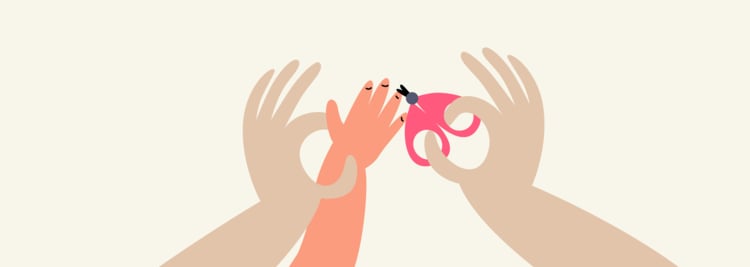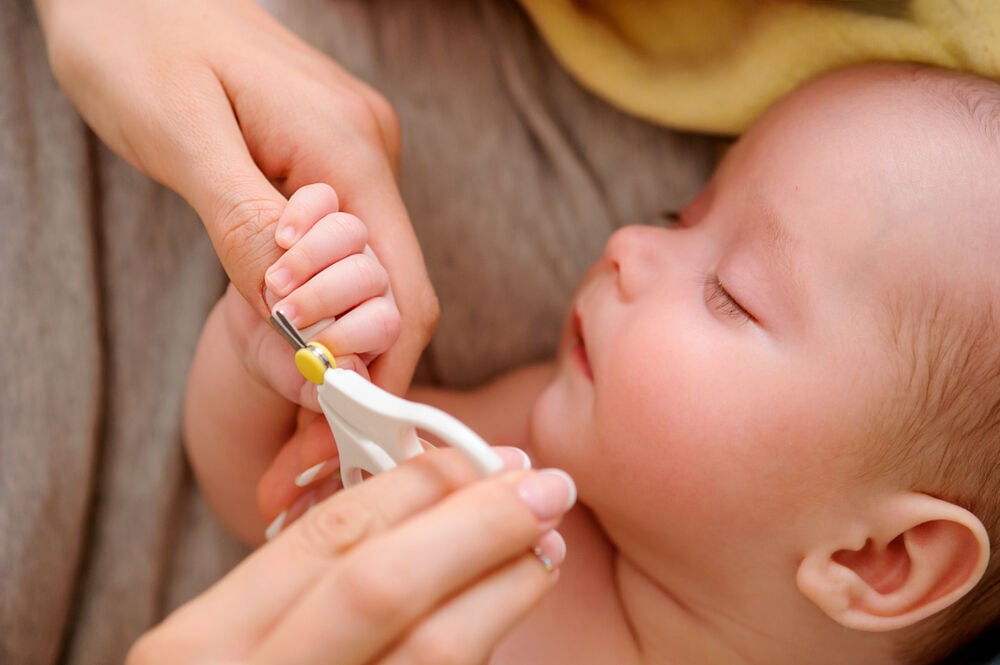Cutting their baby’s nails is something some new parents have never thought about before. The task can seem overwhelming and stressful. Luckily, if you’re prepared with a pair of baby nail scissors and this guide, you’ll be able to handle the task with no problems. Keep reading for the full breakdown of why you should cut a baby’s nails, several tips on how to do it, how often you should do it, and more.
-
Tracking cycle
-
Getting pregnant
-
Pregnancy
-
Help Center
-
Flo for Partners
-
Anonymous Mode
-
Flo app reviews
-
Flo Premium New
-
Secret Chats New
-
Symptom Checker New
-
Your cycle
-
Health 360°
-
Getting pregnant
-
Pregnancy
-
Being a mom
-
LGBTQ+
-
Quizzes
-
Ovulation calculator
-
hCG calculator
-
Pregnancy test calculator
-
Menstrual cycle calculator
-
Period calculator
-
Implantation calculator
-
Pregnancy weeks to months calculator
-
Pregnancy due date calculator
-
IVF and FET due date calculator
-
Due date calculator by ultrasound
-
Medical Affairs
-
Science & Research
-
Pass It On Project New
-
Privacy Portal
-
Press Center
-
Flo Accuracy
-
Careers
-
Contact Us
How to Cut Baby Nails Safely: A Step-by-Step Guide


Every piece of content at Flo Health adheres to the highest editorial standards for language, style, and medical accuracy. To learn what we do to deliver the best health and lifestyle insights to you, check out our content review principles.
Why cut baby nails?
Babies’ lack of muscle control means they can easily scratch their face or eyes. Children are very flexible, and in the first weeks of their lives, they can’t control their arms or legs. Keeping a baby’s nails trimmed keeps them from accidentally hurting themselves.
Your infant’s nails may seem soft and pliable, but that doesn’t mean they can’t hurt themselves with them. An additional concern is that your baby might accidentally scratch you with their nails. Protect both yourself and your baby by learning when and how often to trim their nails.
Regular trimming can also help prevent ingrown nails. An ingrown nail can be painful and lead to a serious infection. If a baby has an ingrown nail, it requires a trip to the doctor’s office to resolve.
When to start cutting baby nails
Babies’ nails grow quite quickly, and they can become sharp and ragged before you realize it. A few days after you come home from the hospital, it may already be time to cut your baby’s nails. When a baby is very small, their nails are so soft that you’ll be able to peel the ends off. If you have trouble doing this, you can also have the baby wear mittens for the first few weeks.
Often, your baby’s nails are naturally worn down by their interactions with the environment and their clothing. However, as their nails grow stronger, you’ll eventually need to switch to baby nail clippers. Many parents also choose to use a nail file to keep their baby’s nails smooth and at a safe length.
How often to cut baby nails
How often you cut your baby’s nails will depend on how quickly they grow. In the first few weeks, it may surprise you how quickly they grow. Newborns may require nail trimming multiple times per week. As they become a couple of weeks old, you’ll only have to cut their nails weekly or semi-weekly. Toenails don’t grow quite as quickly as fingernails!
Take a quiz
Find out what you can do with our Health Assistant
How to cut baby nails safely

Some parents will find it easier to cut a baby’s nails with the help of their partner or another adult. One person can hold the baby and keep them from squirming while the other focuses on cutting the nails.
Find a comfortable position with adequate light. This could be a chair where you can place the baby in your lap or a bed where you can lay the baby down. Some parents try to cut their baby’s nails while they sleep.
Make sure you’re prepared with the right supplies. Instead of using an adult nail clipper, use special baby fingernail clippers. Baby nail scissors have blunt, rounded tips for safety. Additionally, if you’re using an emery board, use a babyproof one. A metal emery board can damage your baby’s soft skin by mistake. If you cut your baby’s nails short enough, an emery board won’t be necessary.
Instead of using an adult nail clipper, use special baby fingernail clippers. Baby nail scissors have blunt, rounded tips for safety.
Some parents who are unsure about using baby clippers may feel more comfortable using an emery board. This will take longer but feels safer for some parents. However, it’s important to be careful and not file down too far and scrape the baby’s soft skin.
Hold your baby’s palm and finger steady with your nondominant hand and cut with the baby scissors in your dominant hand.
It can be helpful to sing or talk to your baby to soothe them as you complete the trimming. When newborns are alert, they tend to clench their hands into fists. Try to relax your baby as much as possible. A great time to cut an infant’s nails is after bath time. After a bath, the nails are slightly softer, and the baby tends to be relaxed. If the baby is particularly tense, just put some mittens on them and try again later. Older babies can be distracted with a toy.
Push down on your baby’s finger pad to provide some space between it and their fingernail while you cut. Stick to short, small cuts above the white nail line. For toenails, cut straight across. Fingernails can be straight across or with slightly rounded edges. Cutting straight across can help to prevent ingrown nails. After cutting, smooth out any sharp edges with an emery board.
Because a newborn baby’s toenails are soft, they often tend to curl over the toe. This can make it hard to tell where the nail ends. Go slowly and cut only a little bit at a time. Keep up with regular trimming to avoid the toenails curling over.
Lastly, clean the dirt from under your baby’s nails using lukewarm water and a clean cloth. This prevents bacteria from spreading if the baby does scratch their face or another person. Keep up regular nail cleaning during the baby’s bath times.
Some parents think they have more control if they bite their baby’s nails. This can spread an infection from your mouth to the child, though. You also can’t see what you’re doing and may produce sharp, edged nails or accidentally bite your child.
What if you cut your baby’s finger?
If you cut your baby’s finger, don’t panic. Apply pressure to the cut with some sterile gauze until the bleeding stops. The bleeding will usually stop quite quickly. Next, rinse the cut with cool water and cover it with sterilized gauze. Avoid bandages as babies love to put their hands and feet in their mouths and can choke on the dressing. If you’re worried about the cut, take your baby to see a doctor.
Ask for help
Cutting your infant’s nails can be a stressful activity, especially for new parents. If you’re uncomfortable or worried about the task, you can ask a friend or relative for help or to show you how it’s done.
Summary
Having to cut your baby’s nails can seem like a daunting task. If your baby struggles and you’re unsure of yourself, you may be afraid of accidentally hurting them. However, cutting a baby’s nails is very important to avoid scratching, infections, and possible ingrown nails.
Find yourself a pair of baby nail scissors and get comfortable with this task. A baby’s nails grow quickly, and you’ll need to trim their nails often. As time goes by, you’ll get practice and feel more and more comfortable with the process.


Hey, I'm Anique
I started using Flo app to track my period and ovulation because we wanted to have a baby.


The Flo app helped me learn about my body and spot ovulation signs during our conception journey.


I vividly
remember the day
that we switched
Flo into
Pregnancy Mode — it was
such a special
moment.
Real stories, real results
Learn how the Flo app became an amazing cheerleader for us on our conception journey.




